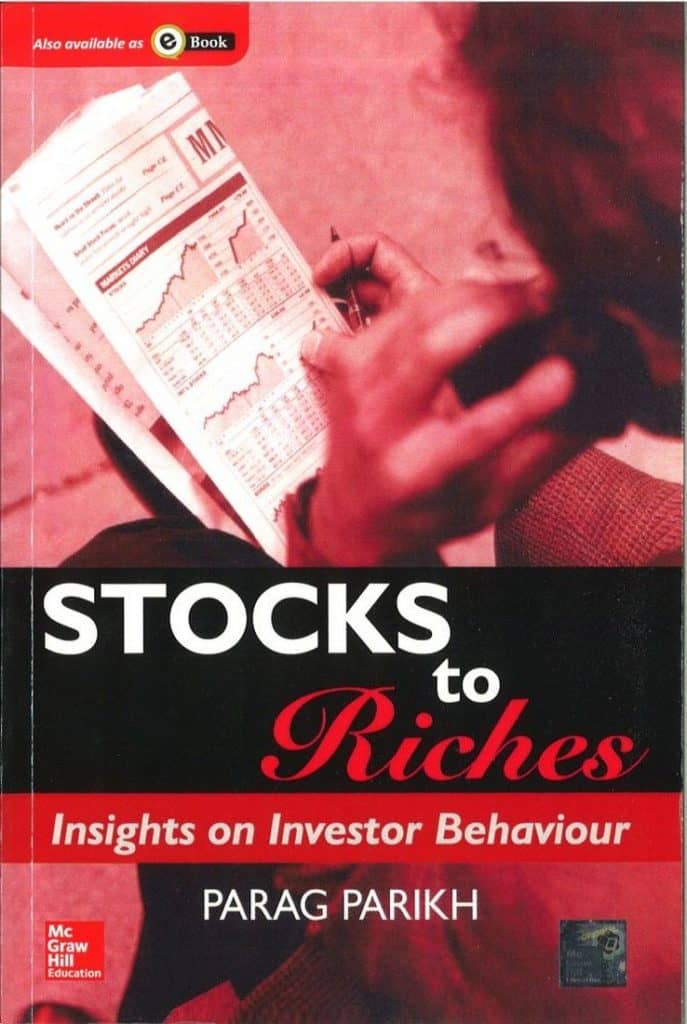
Please welcome Gaurav Menon – the youngest member of Team PrimeInvestor. He takes keen interest in two things – markets and marketing, and he will write occasionally on these topics. Please be kind with your feedback. You can ask him about young-people things – like, fidget spinners and Doge coin 🙂 – Srikanth Meenakshi
There are only a few things in this world that have remained the same as it was a 100 years ago. Human psychology & behaviour is one of them. Stocks to Riches – a book written by Parag Parikh in January 2005 – does a good job of explaining the psychology and as a result, the behaviour of investors in different situations.
A quick note about the author
Parag Parikh was the founder and chairman of Parag Parikh Financial Advisory Services Limited (PPFAS), Mumbai. He started a PMS firm 1996 and later converted it into a mutual fund house in 2003. Right from making the investing limit of his PMS to 5 lakhs (when everyone else was at 25-50 lakhs) to encouraging Indians to remove their home grown bias and asking his employees to invest a majority of their money in their own funds, Parag Parikh was a man full of ideas and on a mission to empower the middle class to invest and grow their wealth. This book (Stocks to Riches) serves as a testament to that fact.
Stocks to Riches – An Overview
Stocks to Riches explains the fundamental concepts one needs to understand, to achieve success in the stock markets. Concepts like investing, differences between trading and speculation, loss aversion, sunk cost fallacy (and how to avoid falling into it), decision paralysis, mental accounting, and herd mentality. Every investor has dealt with and will have to deal with these situations in their investment journey. So having all these concepts neatly compiled and explained in one book certainly helps.

Some key takeaways that I got from reading the book are
An investor can make superior returns if he does his due diligence, knows what’s happening with the world and is emotionally resilient (doesn’t buy stock just because people say so).
The chapter on loss aversion is extremely relatable. He talks about various instances and situations where people from different backgrounds succumb to the sunk cost fallacy. He then gives you a nice checklist to see if you fall into this category and tells you what to do in those situations.
When your investment has failed, remember that your goal should be maximisation of wealth, not justifying your purchase.
The section on “Segregate gains and Integrate losses” provides a good insight into making the most out of your investments and life in general. The main thing here is to spread out positive moments as much as possible and finish off all the negative experiences in one go (For example: when you have to pay your taxes, pay them in one go rather than in instalments).
The chapter on “Mental Accounting” has a lot of examples that one can relate to in their own lives. The crux of it is to treat money as money and not co-relate the utility of the money to the source.
The author is quite critical of actively-managed, open-ended mutual funds for the simple reason that the fund manager is often forced to sell in inopportune moments (market crashes) due to redemption pressures. Not surprising, since he was not managing a fund when he wrote this book! 😀
At the beginning of this review, I had mentioned that the psychology and behaviour of human beings has not changed in the last 100 years. One way to vindicate this is by reading the next chapter on “Market Bubble”. The main concepts in this chapter are as relevant today as it was back in the bull market of 2007. In fact, it’s uncanny how apt it is even to today’s bull market.
The Chapter on “Market Bubble” provides keen insights into how the stock markets function as a system. He starts by breaking down and naming a few parts of the system (Govt., regulator, exchanges, brokers and so on…) that make up the stock market and tells you their intention for being in the markets. This does a good job of drawing the bigger picture of the stock market. The key part of this chapter comes next where he gives you the fundamentals behind a market bubble. He illustrates this with various diagrams and examples. He also tells you the psychology behind a bubble and gives you a step-by-step insight into how a bubble is formed and how it breaks. Simply comparing the points in this chapter to our current gravity-defying markets makes this book worth the purchase.
The book ends with a copied & pasted chapter from Rich dad Poor dad where he tells you why you should invest and why he prefers stocks as an investment (grows faster than inflation).
Overall, the style of writing is extremely simple, easy to understand and filled with stories, anecdotes & situations that help the reader understand the different concepts through various angles.
Who is this for?
This book is for you IF you are –
- Somebody who’s serious about building wealth the right way (not trading but investing), this book is for you
- New to investing & want an idea of what’s in store for you, this book is for you
- An experienced investor, but want to build a framework for handling your emotions during your journey, then this book is for you
Some Interesting Quotes from Stocks to Riches
“Life is all about doing something to reap benefits in the future. So all of us are in the investment game.”
“Booms are always followed by busts and this occurs due to totally opposite behaviour from the same participants. It’s a tug of war between fear and greed and greed and fear.”
“On Investment Vehicles: Why do we have so many different types of cars and trucks? Because different people have different needs. A farmer would find the Tata Sumo useful at his village, while a couple staying in a city would find the Maruti 800 more convenient. Likewise, a Toyota Qualis would well suit a large family. Similarly, in the investment world, investment products are also known as Investment Vehicles.”
“On Rebalancing: Whatever goes up must come down and vice versa. So, we need to make a call. Sell a portion of that asset class which resembles the profit and move that money to another asset class where the trend is bearish. What happens? The asset remains intact, but the money earned from that asset class has moved to a different asset class where the chances of an upside are much more. Thus, you are increasing the velocity of your money.”
“In the investment world some people use stocks for capital gains by trading while others use stocks for cash flow by investing long-term.”
“If we invest in the right stocks with the right business model and fundamentals, over the long run we are assured of optimum returns.”
“Mental Accounting is the tendency to place different values to the same sum of money depending on how it has been acquired and the effort required to acquire it. People mentally separate their money in different accounts, giving each account a different significance.”
“Successful investors sometimes believe that they are skilful because they are doing well with their investments. However, they fail to realise that their investment performance is the result of the stock market performance, not necessarily their individual abilities.”
Relevant to the current time period as well –
He wrote this in 2005: “At present our fiscal deficit is alarming but the markets believe we will tide over this impending crisis. Should the markets crash, as it portends, the analysts will blame the government’s fiscal imprudence. But today one would be a fool to short sell because it does not pay to go against the herd in the short run. Moreover no one can predict when this predictable surprise will come.”
He wrote this about why open-ended mutual funds will not flourish. It’s also extremely relevant to bitcoin & other cryptocurrencies today: “The savings of millions of investors cannot be subjected to abuse in an industry that encourages speculation.”
“We often tend to look at the big numbers and ignore the small. In money matters it is the small figures that make all the difference”
Link to book in Amazon – Stocks to Riches
(Not an affiliate link)



16 thoughts on “Stocks to Riches – Book Review”
I have this book.. A must read…Your review of the book is also good…
Thank You Sir.
Good review of the book and its correlation with current bull scenario. keep up.
Thank You Sir.
Nice review about book
Thanks
Thank You Sir.
Extremely well written review, Gaurav….The book had been on my radar for some time but your review has compelled me to buy… keep writing..
Thank You Sir.
A short and precise introduction to the book. Very well written. Looking forward to more such reviews.
Thank You Sir.
Very thorough review. Well done.
Thank you Sir!
Very well written Gaurav, I read this book somewhere in 2018 and finished it in one go.
It’s quite an eye opener.
Keep writing !!
Thank You sir!
Very nice review! Great way to show the book’s relevance to the current scenario.
Thank You, Sir.
Comments are closed.